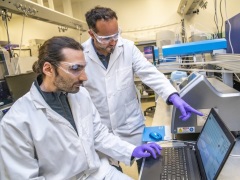Features
Learning about biofuels
Date: 2018-06-14 10:49:14.0
Author: Jon Evans

Zak Costello (left) and Hector Garcia Martin
(right) at Lawrence Berkeley National
Laboratory.
Photo: Marilyn Chung at Berkeley Lab.
Artificial intelligence (AI) has already achieved some impressive feats, from driverless cars to facial recognition to beating human masters of games such as chess and Go. Now, it could also be about to help develop more efficient ways to produce biofuels and biochemicals.
These impressive feats are all down to a form of AI known as machine learning, in which algorithms analyze huge masses of data to find underlying patterns and rules that can be used to predict specific outputs from certain inputs. Crucially, the underlying patterns and rules are implicit to the AI system and can’t be articulated by it, so human developers can never be sure how the system is actually achieving its feats.
In contrast, when designing metabolic pathways for producing novel biofuels and biochemicals, scientists usually know exactly how the pathways work, or hope they do. In reality, pathways tend to work rather differently when actually introduced into microbes, often not proving as efficient as hoped. Although scientists design these pathways with the help of kinetic models, these models can only reflect current understanding of biological processes, which is often not detailed enough for accurate predictions.
“It’s very difficult to predict how a pathway will behave when it’s re-engineered,” says Hector Garcia Martin, a scientist at Lawrence Berkeley National Laboratory in Berkeley, California, US. “Trouble-shooting takes up 99% of our time.”
So together with his colleague Zak Costello, Garcia Martin decided to investigate whether machine learning could assist with designing metabolic pathways. Their approach involved training a machine learning technique known as a tree-based pipeline optimization tool (TPOT) with data from a 2016 study by a team that included scientists from Lawrence Berkeley National Laboratory. In this study, the team developed several metabolic pathways for converting glucose into the biofuels isopentenol and limonene, and introduced them into Escherichia coli.
Garcia Martin and Costello fed data on the best and worst performing of these isopentenol- and limonene-producing pathways, in terms of protein concentration inputs and metabolite concentration outputs, to TPOT. After this training process, they asked TPOT to predict the metabolite concentrations produced by two other isopentenol- and limonene-producing pathways, which the original study had found were medium-performing.
As reported in a paper in npj Systems Biology and Applications, while TPOT’s predictions weren’t perfect, they were more accurate than a conventional kinetic model. Although TPOT only occasionally predicted the correct value for the metabolite concentrations, it usually correctly predicted how they changed over time – whether they rose and then remained stable, for example. It was also fairly accurate at predicting the concentrations of the end products isopentenol and limonene, which was main point of the exercise. In addition, Garcia Martin and Costello showed that TPOT’s predictions became more accurate with more data, which they generated using kinetic models.
This raises the possibility of using machine learning techniques such as TPOT to predict the efficiency of novel metabolic pathways before inserting them into microbes. Only those predicted to be best performing would then be realized, reducing the time and expense involved in developing such pathways. “This approach could expedite the time it takes to design new biomolecules,” says Garcia Martin. “A project that today takes 10 years and a team of experts could someday be handled by a summer student.”
The trick will be producing sufficient experimental data to train the algorithms in the first place, as that will require a lot of time and expense. With enough data, however, scientists will be able to replace TPOT with more advanced machine learning techniques such as deep learning based on neural networks, which is responsible for the most impressive feats of AI, such as driverless cars.
This is also likely to be just the start of what machine learning can offer to biofuels. In a recent paper in Energy Conversion and Management, two scientists from Macau report using machine learning to adaptively control the ratio between a biofuel blend and air in a dual-injection car engine.
The views represented here are solely those of the author and do not necessarily represent those of John Wiley and Sons, Ltd. or of the SCI.
Displaying 2 keywords used to tag this article:
- Jules Audemars-Australia Best Quali
- DG6582 Mens Moncler Down Jackets Gr
